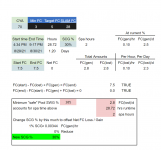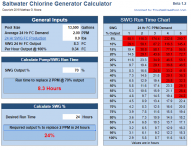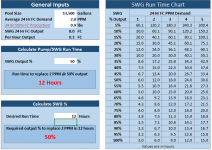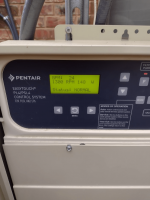Great job! Congratulations on taking full ownership of your pool. "Now let's see how far the rabbit hole goes..."

Now that you've got your FC levels up, what I personally shoot for on my SWG pool is 70 CYA and anything less than FC 10ppm is just fine. There's no downside to having a few extra PPM of FC in a SWG pool with 70 CYA as long as you stay below 10ppm Since the chlorine is effectively free (or very, VERY cheap), it makes sense to give myself several days of margin and I can get really lazy with no worries of algae. Above 10 the pH test becomes unreliable, and for me that's the only test that I focus on day-to-day anymore. Why? Because now that my other numbers have all settled down, first and foremost, the thing that will help keep scale from forming on my SWG is maintaining a slightly negative CSI. I believe I've seen the really knowledgeable folks here say below +0.1, but the general concensus is no higher than +0.0 and no lower than -0.3. Do you have the PoolMath app yet? CSI isn't a direct measurement, but is based on a number of the other tests you should be regularly testing. pH is a large factor, but you'll quickly see how TA and CH, even water temperature play important roles. As you start working on these numbers you will likely find your pool maintenance is running like clockwork and is very easy.
To your question about FC: Running the pump longer at a lower SWG percentage is still totally an option, and it's all up to your personal preference. As long as the salt cell has enough water flow, it will create FC. I don't have an awake enough brain to do the math right now, but with the increased runtime I'm hearing you say that at your current production minus bather load and UV loss, you're making 1ppmFC more than you lose per day, for two days. Looking at the spreadsheet you copied I'm seeing your SWG will produce 0.9 pounds (or 8PPM at your pool's volume) of FC in your pool. That's if you ran the pump 24/7 with SWG set at 100%, you'll make 8PPM / day. You're not running the pump or cell full-out, so you can take: (8ppm / day) * (0.7 Cell percentage) * (Hours of pump runtime) / 24. This gives you your daily chlorine PPM generated.
Now, I see this more-or-less as a conservation of mass problem: (FC end) = (FC start) + (FC generated) - (FC loss to bathers and organics) - (FC loss to environment). I actually modified my version of the pool care spreadsheet to do the math for me, because I'm lazy and this is how it fits into my weird head. I made the formulas automatic so all I need to do is put in the date/time and FC numbers from any two tests, and the calc spits out the correct SWG percentage. (note, I assume my pump will run 24/7, and I even gave it an adjustment for spa runtime, as that's a different SWG percentage level in my pool controls.) With no swimmers and keeping leaves out of the pool this equation becomes very simple indeed, and that's how I personally calculate my daily FC demand.
Questions you might want to explore
- Does your pool pump or automation panel tell you how many watts it is drawing at whatever RPM & CFM? You might find it's actually cheaper to run the pump at just a few hundred RPM over the minimum flow for your SWG to stay on. I've also read it's actually easier for VS pumps and their bearings / seals the lower you run them. I just make sure at least once a day to kick the RPM up to 3000 or so because my system tends to get some air bubbles in the baskets at very low RPMs.
- If it's quiet enough and you don't want to increase your pump hours, you might consider running the pump at night so your pool has higher FC in the morning rather than struggling to keep up during the day. For me I think I'd personally prefer a pool that started the day at 8ppm and slowly fell to 6 over the day, rather than one that struggled to stay at 6 all day and then sat there not catching up at night, only to barely keep up the next day. The total amount of FC created wouldn't change. This is all very strange for me to consider, because I just run my pump all day and don't even think about it because it's silent until the skimmer / floor cleaner setting kicks on.
- As you're continuing your full test panels, start paying attention to the other numbers in the Recommended Levels chart. TA and pH are changed with muriatic acid. CYA and CH levels really don't ever go down quickly in a pool unless you're draining / refilling, or there's heavy rain you're compensating for.
- If your fill water is low enough alkalinity, you might consider adding borates to your pool for added silky feel to the water, it makes algae even harder to grow, and can work wonders with keeping scale from building up on SWG plates. It also does a good job of stabilizing pH from climbing too rapidly with the tradeoff being it takes roughly twice the amount of acid to drop the pH in the pool.
Here's that extra math I added to the spreadsheet.










![IMG_5337[1].PNG IMG_5337[1].PNG](https://www.troublefreepool.com/data/attachments/196/196388-0d32a0bb05e533fe549ba7406095236e.jpg)